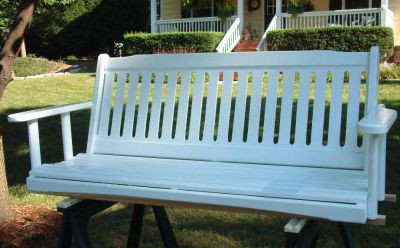Question
I have been building custom, hardwood porch swings for a little over a year now. Most of my swings are made from red or white oak and finished with 3 coats of Sikkens Cetol 1. After many failures with other products, the Cetol 1 is proving to be far superior! My current dilemma is finding a durable and lasting painted finish for the models built from poplar. I had been using Ben Moore DTM (Direct to Metal) over Zinzeer primer, at the suggestion of a retailer. But I'm experiencing peeling and blistering after six months' exposure to the North Carolina weather.

Forum Responses
(Finishing Forum)
From contributor L:
Stay with Sikkens, and use their solid stain.
Oil-base primer and paint has the best moisture excluding effectiveness. Six coats of primer/paint will give you a moisture excluding effectiveness of 89%. Three coats provides 80%. It also seals in the water soluble extractives in some wood species that can bleed through the primer/paint and cause discoloration. The three woods listed above contain water soluble extractives.
An oil-base enamel paint rated for exterior use on wood will give you the best service life on furniture. It contains additives to promote flexibility and protect the binder from UV as well as mildewcides.
Before assembling the furniture, seal the end grain very well with the paint. If the wood absorbs moisture, the paint will fail prematurely. If you use screws to assemble the piece, it's best to pre-drill the holes and squeeze in some epoxy just before you screw it together. The epoxy will keep moisture out of the openings the screws create.
Also, make sure the moisture content of the wood is low before painting. If it's too high, the paint will peel. Sand just before painting to give the primer/paint a fresh wood surface to adhere to. Oxidized/weathered wood doesn't hold paint as well. If you skip the primer, thin the first coat of paint to promote penetration and adhesion.
Also, all of the wood I use is new stock, 5/4 planed to thickness. I could use woods other than poplar for my painted units, but cost is higher and availability is an issue, here in North Carolina. Most of the peeling is happening at edges, like the bottom of the vertical back slats on the piece pictured.
A large, white swing frame that I built to display these was painted with latex primer and Muralo Exterior Mid-Gloss, and it has weathered well so far. And just to clarify for the first two responses, I use the Sikkens Cetol for my oak, stained models, and that is working very well. It's just the painted models that I'm having problems with.